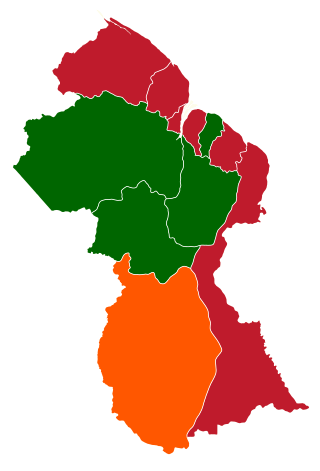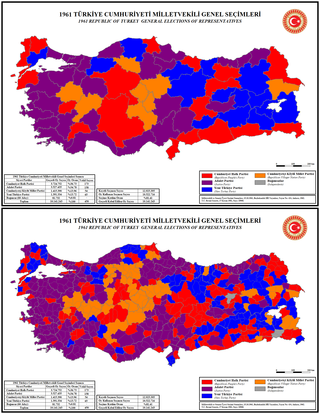
Party-list proportional representation (list-PR) is a subset of proportional representation electoral systems in which multiple candidates are elected through their position on an electoral list. They can also be used as part of mixed-member electoral systems.

The single transferable vote (STV), sometimes known as proportional ranked choice voting (P-RCV), is a multi-winner electoral system in which each voter casts a single vote in the form of a ranked-choice ballot. Voters have the option to rank candidates, and their vote may be transferred according to alternate preferences if their preferred candidate is eliminated or elected with surplus votes, so that their vote is used to elect someone they prefer over others in the running. STV aims to approach proportional representation based on votes cast in the district where it is used, so that each vote is worth about the same as another. Formally, STV satisfies a fairness criterion known as proportionality for solid coalitions.
The Droop quota is the quota most commonly used in elections held under the single transferable vote (STV) system. It is also sometimes used in elections held under the largest remainder method of party-list proportional representation. Any candidate that receives quota is declared elected. Under some STV systems, especially those of the full-preferential voting variant, all the winners receive the quota, but in others, of the optional-preferential voting or semi-optional preferential voting variants, it is common for as many as three winners in a district to be elected with less than quota.
The largest remainder method is one way of allocating seats proportionally for representative assemblies with party list voting systems. It contrasts with various highest averages methods.
The Hare quota is a formula used under some forms of proportional representation. In these voting systems the quota is the number of votes that guarantees a candidate, or a party in some cases, captures a seat. The Hare quota is the total number of votes divided by the number of seats to be filled. This is the simplest quota, but the Droop quota is mostly used currently.

The Zimbabwe government consists of an elected head of state, the president, and a legislature. The presidential term lasts for 5 years, and is elected by majority, with a second round if no candidate receives a majority in the first round. The Parliament is bicameral, consisting of the House of Assembly and Senate. Following the 2013 constitution, the House of Assembly has 270 members. 210 are elected for five-year terms by single-member constituencies. Furthermore, the constitution specifies that for the two first parliaments, there are 60 additional seats reserved for women, 6 seats per province, which are filled based on the votes for in the single-member constituencies, using party-list proportional representation, distributed using the largest remainder method and the hare quota. The Senate has 80 members: 60 are elected for five-year terms in 6-member constituencies representing one of the 10 provinces, elected based on the votes in the lower house election, using party-list proportional representation, distributed using the hare quota. Additionally the senate consists of 2 seats for each non-metropolitan district of Zimbabwe elected by each provincial assembly of chiefs using SNTV, 1 seat each for the president and deputy president of the National Council of Chiefs and 1 male and 1 female seat for people with disabilities elected on separate ballots using FPTP by an electoral college designated by the National Disability Board.
The Edmonton provincial electoral district also known as Edmonton City from 1905 to 1909, was a provincial electoral district in Alberta, Canada mandated to return members to the Legislative Assembly of Alberta from 1905 to 1917 and again from 1921 to 1959.
The Hagenbach-Bischoff system is a variant of the D'Hondt method, used for allocating seats in party-list proportional representation. It usually uses the Hagenbach-Bischoff quota for allocating seats, and for any seats remaining the D'Hondt method is then applied so that the first and subsequent divisors for each party list's vote total includes the number of seats that have been allocated by the quota. The system gives results identical to the D'Hondt method and it is often referred to as such in countries using the system e.g. Switzerland and Belgium. Luxembourg uses the Hagenbach-Bischoff method to allocate seats in its European Parliament elections.

The 1958 Italian general election was held in Italy on 25 May 1958. The number of MPs to be elected was calculated upon the population's size for the last time.

The 1983 Italian general election was held in Italy on 26 June 1983. The Pentapartito formula, the governative alliance between five centrist parties, caused unexpected problems to Christian Democracy. The alliance was fixed and universal, extended both to the national government and to the local administrations. Considering that the election result did no longer depend on the strength of the DC, but the strength of the entire Pentapartito, centrist electors began to look at the Christian Democratic vote as not necessary to prevent a Communist success. Moreover, voting for one of the four minor parties of the alliance was seen as a form of moderate protest against the government without giving advantages to the PCI. Other minor effects of this election were a reduction of the referendarian Radical Party and the appearance of some regional forces.

The 1987 Italian general election was held in Italy on 14–15 June 1987. This election was the first Italian election in which the distance between the Christian Democrats and the Communists grew significantly instead of decreasing. Two parties that had not previously been in parliament won representation: the Greens with thirteen seats, and the Northern League with two.

General elections were held in Italy on Sunday 2 and also on Monday 3 June 1946. They were the first after World War II and elected 556 deputies to the Constituent Assembly. Theoretically, a total of 573 deputies were to be elected, but the election did not take place in the Julian March and in South Tyrol, which were under military occupation by the United Nations.

Folketing elections were held in Denmark on 22 April 1918, the first in which women could vote. The result was a victory for Venstre, which won 45 of the 140 seats in the Folketing, which had been expanded from 114 to 140 seats. Voter turnout was 75.5%.

Parliamentary elections were held in Russia on 12 December 1993. They were the first parliamentary elections in post-Soviet Russia and the only time to the Federation Council, with future members appointed by provincial legislatures and governors.

General elections were held in Guyana on 19 March 2001. The result was a victory for the People's Progressive Party/Civic, which won 34 of the 65 seats. Voter turnout was 91.7%.
Parliamentary elections were held in Iceland on 25 April 1987. The Independence Party remained the largest party in the Lower House of the Althing, winning 12 of the 42 seats.
In elections that use the single transferable vote (STV) method, quotas are used (a) for the determination of candidates considered elected; and (b) for the calculation of surplus votes to be redistributed. Two quotas in common use are the Hare quota and the Droop quota. The largest remainder method of party-list proportional representation can also use Hare quotas or Droop quotas.

Parliamentary elections were held in Niger on 14 February 1993. They were the first multi-party elections in the country since independence in 1960, and followed constitutional changes approved in a referendum the previous year. Although the ruling National Movement for the Development of Society won the most seats, several opposition parties formed the Alliance of the Forces of Change following the elections, between them controlling 50 seats. Voter turnout was just 32.7%.

General elections were held in Turkey on 15 October 1961. The Republican People's Party (CHP) emerged as the largest party, winning 173 of the 450 seats. It was the first time the CHP had won the most seats after the transition to a multi-party system, and the first time no party won a majority of seats. Voter turnout was 81%.
National remnant is a method used to allocate seats in a party-list proportional representation electoral system that has electoral districts. The system uses a Largest remainder method to determine some of the seats in each electoral district. However, after the integer part of the seats in each district is allocated to the parties, the seats left unallocated will then be allocated not in each electoral district in isolation, but in a larger division, such as nationwide or in large separate regions that each encompass multiple electoral districts.
















